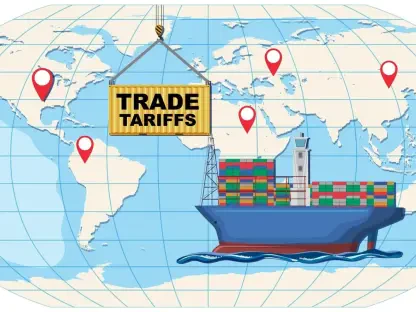Imagine a single week where nearly 2,000 jobs vanish across a critical industry, leaving workers in states like California, Georgia, and Michigan grappling with uncertainty. This staggering reality has hit the US logistics and supply chain sectors hard, as giants from packaging to delivery services announce sweeping layoffs and facility closures. What drives such drastic measures in an industry once seen as a backbone of economic stability? This roundup dives into a collection of opinions, tips, and analyses from industry experts, corporate leaders, and workforce advocates to uncover the root causes, compare differing viewpoints, and explore potential paths forward for companies and employees alike.
Examining the Surge of Job Cuts in Logistics
The scale of recent layoffs in the logistics sector has sparked intense discussion among stakeholders. Reports indicate that 1,967 jobs were cut in a matter of days across multiple states, with major players like International Paper in Georgia and Web to Door in California bearing the brunt of these reductions. Industry observers note that this wave of job losses isn’t merely a numbers game; it reflects deeper systemic challenges that demand urgent attention.
Beyond the raw data, there’s a consensus that these cuts signal a turning point for the sector. Analysts highlight how the layoffs span diverse sub-industries, from food delivery to containerboard manufacturing, pointing to interconnected vulnerabilities. Some argue that this could be a precursor to even larger disruptions if underlying issues remain unaddressed, while others see it as a necessary recalibration for long-term growth.
A key point of debate is the immediate impact on local economies. In regions like Georgia, where over 1,200 jobs have been lost due to facility closures, community leaders express concern over the ripple effects on small businesses and families. This roundup aims to unpack these perspectives, shedding light on why such drastic workforce reductions are happening now and what they mean for the future.
Key Drivers Behind the Layoff Wave: Diverse Opinions
Operational Challenges and Facility Shutdowns
One prominent view centers on operational inefficiencies as a primary cause of layoffs. Industry analysts point to outdated infrastructure, particularly in facilities like those closed by International Paper in Savannah and Riceboro, Georgia, affecting 1,093 workers. Many believe that companies face a tough choice between investing in costly upgrades and shutting down underperforming sites to ensure sustainability.
Contrasting opinions emerge on whether these closures were inevitable. Some corporate strategists argue that modernizing aging plants is often financially unfeasible, especially in a competitive market. They cite examples like Hormel Foods halting bacon production in Tucker, Georgia, impacting 135 employees, as a pragmatic move to relocate operations rather than sink funds into outdated systems.
On the other hand, workforce advocates suggest that alternative investments, such as phased renovations or public-private partnerships, could have mitigated job losses. They emphasize that short-term cuts might save costs but risk eroding institutional knowledge and community trust. This divide in thought underscores a broader tension between immediate survival and long-term planning in the logistics sector.
Contract Losses and Market Shifts
Another widely discussed factor is the loss of key contracts and changing business demands. Experts highlight cases like J.B. Hunt Transport Services and DP World, which together cut 258 jobs in Georgia and Michigan due to distribution center closures after losing major clients. Many see this as evidence of the dangers of over-reliance on single partnerships in a volatile market.
A deeper dive into specific impacts reveals stark examples, such as Web to Door ceasing operations at three California locations tied to Amazon delivery services, affecting 192 workers. Some industry watchers argue that such dependency creates a precarious business model, leaving companies vulnerable to sudden shifts in client priorities or market trends.
Solutions-oriented voices propose diversification as a critical buffer against these risks. They suggest that logistics firms should broaden their client base and explore emerging sectors to reduce exposure to abrupt contract terminations. However, skeptics caution that diversification requires time and capital—resources many companies lack during economic downturns—highlighting a complex challenge with no easy fix.
Economic Strain and Cost-Cutting Pressures
Economic pressures also feature prominently in discussions about the layoff surge. Observers note that broader challenges, such as inflation and rising operational costs, push firms toward aggressive cost-cutting, as seen with temporary layoffs at Silgan Containers in California (150 jobs) and permanent closures by Green Rabbit in Visalia (107 jobs). Many agree that these moves reflect a survival instinct amid tightening budgets.
Regional differences add another layer to the conversation. In California, high operational costs exacerbate financial strain, while Georgia’s manufacturing-heavy focus faces unique supply chain disruptions. Some analysts predict that these variations could shape future layoff patterns, with companies potentially relocating to lower-cost areas, though this raises concerns about job displacement in already hard-hit regions.
A critical perspective questions the long-term efficacy of cost-cutting as a strategy. Certain thought leaders warn that slashing jobs might undermine innovation and morale, leaving firms ill-prepared for recovery. They advocate for balanced approaches, such as targeted investments in efficiency, to avoid sacrificing future competitiveness for short-term gains—a viewpoint that sparks ongoing debate.
Interconnected Industry Impacts
The ripple effects of layoffs across interconnected industries draw significant attention. From packaging to logistics, as seen with GXO Logistics cutting 32 jobs in California, the breadth of affected sectors illustrates how supply chain disruptions cascade through the economy. Many experts stress that no segment operates in isolation, amplifying the stakes of each closure or reduction.
Comparisons between industries reveal shared struggles and potential solutions. Some commentators point out that modernization is a common need, whether in food delivery or freight transport, with automation looming as both a threat and an opportunity. While it could streamline operations, there’s concern that accelerated adoption might further displace workers, a fear echoed by labor groups.
Amid these strategic discussions, the human cost remains a focal point. Nearly 2,000 layoffs in a short span represent not just corporate restructuring but profound personal upheaval for workers and families. Advocates for affected employees urge companies to prioritize support mechanisms, such as severance packages or retraining, to soften the blow—a reminder of the need to balance profit motives with social responsibility.
Lessons and Strategies from Industry Voices
Drawing from varied insights, several core reasons for the layoffs stand out: operational inefficiencies, lost contracts, and economic strain. The scale of nearly 2,000 job cuts across states like California and Georgia underscores the urgency of addressing these issues. Experts collectively emphasize that ignoring systemic flaws could lead to recurring crises, pushing for proactive rather than reactive measures.
Actionable strategies emerge as a common thread in the discourse. Investing in technology to modernize facilities is frequently cited as a way to boost efficiency without sacrificing jobs. Additionally, diversifying client portfolios to mitigate dependency risks and upskilling workers for evolving industry needs are seen as vital steps to build resilience among both companies and their employees.
Practical advice for stakeholders also surfaces. Companies are encouraged to communicate layoff decisions with transparency, ensuring workers understand the rationale and available support. For employees, seeking retraining programs or exploring growth niches within logistics, such as e-commerce fulfillment, offers potential pathways. These tips aim to bridge the gap between corporate necessity and workforce stability, fostering a more adaptive industry landscape.
Reflecting on the Path Taken
Looking back, the roundup of perspectives painted a multifaceted picture of the logistics layoff crisis, revealing operational, economic, and contractual challenges as key drivers behind nearly 2,000 job cuts. The dialogue among industry experts, corporate leaders, and advocates brought to light both the urgency of strategic realignment and the profound human toll of these decisions. Differing views on modernization versus preservation, and cost-cutting versus investment, underscored the complexity of navigating this turbulent period.
Moving forward, stakeholders are encouraged to prioritize collaborative solutions, such as partnerships for workforce retraining or incentives for technological upgrades, to prevent future waves of layoffs. Exploring emerging logistics trends, like sustainable supply chains, could also open new opportunities for growth and stability. This reflection serves as a call to action, urging companies and policymakers to invest in resilience while supporting those most affected by the recent cuts, ensuring that lessons learned pave the way for a stronger, more equitable industry.









